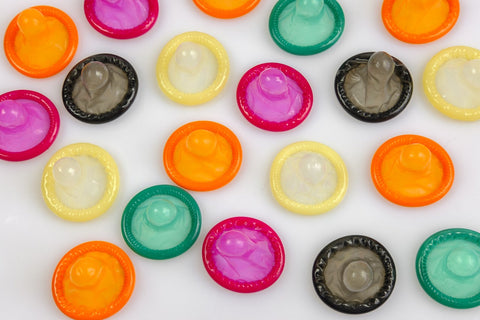Curious about condoms? Condoms are sexual barriers that have been around for thousands of years. Though they were originally made from fabrics and animal skins, today’s condoms are made from latex and other synthetic materials, like polyurethane and polyisoprene.1 Through each iteration, condoms have become easier to use and more effective in protecting against pregnancy and STIs.
Whether you’re gearing up for your first time or a regular condom connoisseur, it’s important that you understand condom effectiveness so that you and your partner can properly protect yourselves against STIs and accidental pregnancy. Read on to learn all about condom effectiveness, how to properly use condoms to avoid pregnancy, and more. Or, use the links below to jump ahead to a section of your choosing.
- How Effective Are Condoms at Preventing Pregnancy?
- Best Practices for Using Condoms to Avoid Pregnancy
- Comparing Condom Effectiveness with Other Birth Control Methods
How Effective Are Condoms at Preventing Pregnancy?
Interested in learning what condoms can and can’t do? You’ve come to the right place. Let’s review condom effectiveness.
Condom Effectiveness
When it comes to sex, condoms have many uses. For one, they prevent the transmission of some sexually transmitted infections (STIs). Condoms can help prevent STIs that transmit through body fluids including chlamydia, gonorrhea, trichomoniasis, HIV, and hepatitis B. However, they are less effective at preventing STIs that transmit through skin contact like herpes, genital warts, and syphilis.
Even if you use condoms correctly every time you have sex, regular STI testing is still a good idea, especially if you’ve recently had sex with a new partner. Not only can this help you identify any STIs you may need to treat, but it can also prevent you from passing STIs on to your partner.
How Reliable Are Condoms Against Pregnancy?
Condoms do not prevent pregnancy 100% of the time. It is absolutely possible to get pregnant when using condoms. When used correctly, condoms alone are 98% effective in preventing accidental pregnancy.2 That means that for every 100 people who have sex, an average of 2 people can become accidentally pregnant each year, even if they’ve followed proper condom use to a T.
Best Practices for Using Condoms to Avoid Pregnancy
While it is true that condoms are 98% effective, in the real world things don’t quite shake out that way. When it comes to condoms and pregnancy prevention, about 15 out of every 100 people who use condoms become accidentally pregnant each year—a prevention rate of just 85%.1
While condoms are highly effective, user error contributes to the additional 13% of contraceptive failure. This can happen when condoms aren't used correctly, leak, slip off during sex, or accidentally break.
How to Use Condoms Correctly
In order to unlock complete condom effectiveness, it’s important to learn how to use a condom correctly. Even if you’ve been using condoms for years, it’s a good idea to brush up on proper condom use and make sure you’ve done it correctly. Just one instance of improper condom use can result in an accidental pregnancy, so you’ll need to properly use a condom every time.
To correctly use a condom, follow these steps:3
- Check the condom: Prior to using a condom, carefully check the packaging for tears or defects. Check the expiration date, too. If the condom is expired or damaged, throw it away and get another.
- Open the condom: Carefully push the rolled edge of the condom to the side and tear the package open. Do not use your teeth or scissors to open a condom package, as they might accidentally rip or poke a hole through the condom.
- Put the condom on: Place the condom on the tip of the penis with the rolled side out. This will allow you to properly unroll the condom. If you’re uncircumcised, pull the foreskin back first.
- Pinch the tip: Create a half-inch gap at the tip of the condom, pinching the air out.
- Unroll the condom: Keeping your fingers pinched at the tip, use your other hand to completely unroll the condom down the shaft of the penis. Completely unroll the condom to cover as much surface area as possible.
Proper condom removal is just as important as its application. Here’s how to do it correctly:
- Hold the condom in place: After ejaculation, it’s important to hold the condom in place so that it doesn’t slip off while withdrawing from your partner.
- Pull it off from the base: Carefully pull the condom off from the base, rather than the tip.
- Throw it in the trash: Never flush a condom.
Can You Get Pregnant When Using Condoms? Common Mistakes to Avoid
You can still get pregnant while using a condom. Avoid these common mistakes to lower your chances of accidental pregnancy.
- Don’t have contact before applying: Make sure there’s no contact between the penis and the vagina before applying the condom. Even prior to ejaculation, sperm is able to enter the vagina via pre-ejaculate fluid.
- Don’t flip it: If you accidentally put the condom on rolled-side down, don’t flip it over and try again. There may be pre-ejaculate fluid on the condom. When flipped, the pre-ejaculate fluid can come into direct contact with the vagina and cause an accidental pregnancy. Throw it away and start over.
- Don’t store condoms in your wallet: While a condom in the wallet is a common trope in movies and TV, it’s actually a bad idea. Friction can wear out a condom and cause it to tear and sharp objects in your wallet may accidentally puncture your condom. Excessive heat over 104 degrees can also damage condoms, so it’s best to keep them out of your wallet and in a cool, dry place.4
- Don’t use oil-based products: Do condoms break? They will if you use them with the wrong products. Baby oil, oil-based lotions, petroleum jellies, and coconut oil can cause a condom to break, so it’s best to avoid.
- Don’t skip the lubricants: Natural friction that occurs during sex can also cause condoms to break, so it’s important to make sure there’s as little friction as possible. A good lubricant can reduce excess friction—and improve sensation! Use water-based or silicone-based lubricants.
- Don’t use double up: Using more than one condom at a time is a sure-fire way to cause breakage. Always use just a single condom. If you’d prefer an internal condom to an external, choose between the two.
- Don’t re-use a condom: No amount of emptying or washing will ever make reusing a condom safe or hygienic. Always throw a condom away after use and never reuse an old condom.
Comparing Condom Effectiveness with Other Birth Control Methods
Of course, condoms are not the only form of birth control. Other birth control methods and their efficacy include:
- Implants: Birth control implants are inserted into the arm and release a contraceptive hormone. They are 99.95% effective.
- IUD: IUDs are hook shaped devices inserted into the fallopian tubes that trigger an immune response in the body that prevents pregnancy. They are between 99.92% and 99.98% effective.
- Sterilization: Sterilization is available to both men and women. It is between 99.95% and 99.85% effective.
- Birth control injection: A hormonal contraceptive that is injected into the body every 3 months. It is 94% effective.
- Birth control pill, patch, or vaginal rings: Additional methods of hormonal contraceptives. They are 91% effective.
- Diaphragm: A dome-shaped cup that is inserted over the cervix prior to sex and blocks sperm from entering the uterus. It is 88% effective.
- Cervical cap: Like a diaphragm, a small rubber cup that is inserted over the cervix prior to sex and blocks sperm. It is between 78% and 83% effective.
- Sponge: A small sponge that contains spermicide that is inserted over the cervix before sex. It both blocks the entrance to the uterus and contains sperm-slowing spermicide, preventing sperm from reaching the egg. It is between 76% and 88% effective.
- Fertility awareness-based methods: These methods involve tracking your cycle to avoid sex on most fertile days. They are 76% effective.
- Spermicide: A substance that slows sperm down, preventing them from reaching the egg. It is 28% effective.
How Effective Is Birth Control and Condoms Combined?
Though no combination of contraceptives will ever be 100% effective against accidental pregnancy, combining birth control methods will give you the most protection possible. The best way to increase condom efficacy is to combine it with another form of birth control, especially a highly effective form. Using the two together reduces your risk of pregnancy even further.
References
- Medibank. “The History of the Condom.” Be Magazine, Medibank, www.medibank.com.au/livebetter/be-magazine/wellbeing/the-history-of-the-condom/. Accessed 10 Oct. 2024.
- NHS Inform. “Condoms.” NHS Inform, www.nhsinform.scot/healthy-living/contraception/condoms. Accessed 10 Oct. 2024.
- Centers for Disease Control and Prevention (CDC). “Condom Use.” CDC, www.cdc.gov/condom-use/index.html. Accessed 10 Oct. 2024.
- Minnesota Department of Health. “Storage of Condoms.” Minnesota Department of Health, www.health.state.mn.us/diseases/hiv/partners/storage.pdf. Accessed 10 Oct. 2024.








